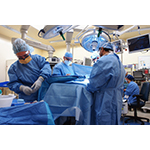Five Lifesaving Organ Transplants in 48 Hours Means a Very Busy Weekend at Lucile Packard Children’s Hospital Stanford
STANFORD, Calif.–(BUSINESS WIRE)–Weekends at Lucile Packard Children’s Hospital Stanford can be busy, but
one recent weekend in July yielded a remarkable 48-hour whirlwind of
multiple organ transplants.
It started Friday night, July 17, when doctors separately performed a
heart-lung transplant and a liver transplant at the hospital. The next
day, three hours after completing the heart-lung surgery, the same
surgeons performed a heart transplant on a baby. Then, on Sunday, a
young girl got a new kidney, while in another operating room a young
adult received a long-awaited liver.
To say it was an action-packed weekend would be an understatement.
“Five transplants in that amount of time is unusual in a children’s
hospital,” said surgeon Carlos
Esquivel, MD, PhD, chief of the division of transplantation and the
Arnold and Barbara Silverman Professor in Pediatric Transplantation at
the Stanford University School of Medicine. “But when it happens, we’re
prepared. This really shows the depth of the institution and our
transplant programs.”
All of the organs came from deceased donors. Unlike with living donors,
the hospital’s transplant teams don’t get much notice – or time – when a
matching organ is located. Often, the organs come at a critical point
for the patient, who may have been on the transplant waiting list for
weeks, months or even years.
“Orchestrating these surgeries takes lots of quick planning and teamwork
across the organization,” said Esquivel, who has been saving
lives through transplantation for more than 30 years. It all starts
with a call from Donor
Network West, an organ procurement organization and one of the
largest tissue-recovery organizations in the nation. They identify a
donor and a match. From there, the teams begin a large and rapid
mobilization of surgeons, anesthesiologists, operating room staff,
transfusion services, lab technicians, social workers, bedside nurses,
coordinators and dozens of other transplant-trained professionals – and,
in this case, they had to do it five times in a very short period.
Ranked
No. 1 in the nation in volume and outcomes, Lucile
Packard Children’s Hospital and Stanford Children’s Health have
developed protocols to ensure that communication and coordination is
seamless during these fast-unfolding situations.
The heart-lung transplant on July 17, involving a gravely ill teen, was
particularly rewarding. The patient’s lung was failing and he was in
imminent danger of dying.
Cardiothoracic surgeons Katsuhide
Maeda, MD, and Olaf
Reinhartz, MD, led that successful surgery; the next day, they also
performed the heart transplant on a baby. Also on that Saturday,
surgeons Amy
Gallo, MD, and Waldo
Concepcion, MD, each guided respective kidney and liver transplants.
Together, Concepcion, Esquivel and Andrew
Bonham had transplanted a liver on that Friday – the first surgery
to kick off the wave of five in those 48 hours.
It was a full weekend of lifesaving surgeries, but not quite a record
for the transplant teams. That’s because in 2013, they performed five
transplants in a 24-hour period.
“When a donor organ is available, we ignore the clock and do whatever
needs to be done,” said Gallo, assistant professor of surgery at the
School of Medicine.
Now, all the patients are in various stages of recovery, and each is
embarking on a new, healthier life.
In the meantime, families are expressing thanks to the transplant teams,
the power of organ donation, and the donor families who, while in the
midst of tremendous grief, made a decision to save the lives of others.
* Read about Stanford’s history of transplant innovation and research here.
*
Find out how to register to be an organ donor at http://donatelife.net.
*
At the Stanford School of Medicine, Olaf Reinhartz, MD, is associate
professor of cardiothoracic surgery; Katsuhide Maeda, MD, is clinical
assistant professor of cardiothoracic surgery; Waldo Concepcion, MD, is
professor of surgery; Amy Gallo, MD, is assistant professor of surgery;
and Andrew Bonham is associate professor of surgery.
About Stanford Children’s Health and Lucile Packard Children’s
Hospital
Stanford Children’s Health, with Lucile Packard Children’s Hospital
Stanford at its core, is the largest Bay Area health care enterprise
exclusively dedicated to children and expectant mothers. Long recognized
by U.S.
News & World Report as one of America’s best, we are a leader in
world-class, nurturing care and extraordinary outcomes in every
pediatric and obstetric specialty, with care ranging from the routine to
rare, regardless of a family’s ability to pay. Together with our Stanford
Medicine physicians, nurses, and staff, we can be accessed through
partnerships, collaborations, outreach, specialty clinics and primary
care practices at more than 45 locations in Northern California and 100
locations in the U.S. western region. As a non-profit, we are committed
to supporting our community – from caring for uninsured or underinsured
kids, homeless teens and pregnant moms, to helping re-establish school
nurse positions in local schools. Learn more at stanfordchildrens.org
and on our Healthier,
Happy Lives blog. You can also discover how we are Building
the Hospital of the Future. Join us on Facebook,
Twitter,
LinkedIn
and YouTube.
Contacts
Lucile Packard Children’s Hospital Stanford
Robert Dicks,
650-497-8364
rdicks@stanfordchildrens.org







